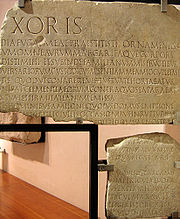
Laudatio Turiae
Encyclopedia

Epitaph
An epitaph is a short text honoring a deceased person, strictly speaking that is inscribed on their tombstone or plaque, but also used figuratively. Some are specified by the dead person beforehand, others chosen by those responsible for the burial...
that is a husband's eulogy of his wife. It was made in the late 1st century BC. It portrays the love of a husband for his loyal wife Curia
Curia (wife of Quintus Lucretius)
Curia or Turia or Thuria was a Roman woman from the Curio family.-Life:She was the wife of Quintus Lucretius Vespillo for 40 years, whom she married sometime between 49 BC and 42 BC. She was from a wealthy family as was her husband. They had no children...
.
This inscription is traditionally known as the "Laudatio Turiae". The attribution is uncertain, but the addressee is generally identified with Turia
Curia (wife of Quintus Lucretius)
Curia or Turia or Thuria was a Roman woman from the Curio family.-Life:She was the wife of Quintus Lucretius Vespillo for 40 years, whom she married sometime between 49 BC and 42 BC. She was from a wealthy family as was her husband. They had no children...
, whence the name of the inscription. W. Ward Fowler states, "...there is a very strong probability that her name was Turia, and that he was
the certain Q. Lucretius Vespillo..."
Tombstone
The frequently moving eulogy inscribed on the stone is addressed from a husband to his deceased wife, lauding her virtues, self-sacrificing love, and unflinching loyalty toward him when she was still alive. The stone itself is broken, and parts have been found scattered around the city of Rome, although some sections remain lost. At 180 lines, the "Laudatio Turiae" is currently the longest surviving personal inscription from Classical Rome.Inscription
The inscription gives a unique insight into the late 1st century Roman world during the rise of Augustus Caesar, as its extended history of "Turia's" life addresses many aspects of the Roman society. "Turia's" selfless deeds in defense of her persecuted husband range from sending him jewelry and money when he was in exile to offering him a divorce so he could have an heir—she was unable to bear children. Her husband also lovingly describes her virtues, among which he includes weaving, obedience, faithfulness to family, and religious purity. According to the inscription, her first accomplishment worthy of praise was avenging her parents’ murder, which gives a rather surprising look into the roles of women within the family and society. The husband also says the marriage was unusual, because it lasted forty years with her dying first while he was much older.Identities
The extant remains of the Laudatio Turiae are unfortunately missing the fragmented piece that contains the identities of both the husband and wife, thus their names remain unknown. However, studies based on comparison with the histories of Valerius MaximusValerius Maximus
Valerius Maximus was a Latin writer and author of a collection of historical anecdotes. He worked during the reign of Tiberius .-Biography:...
(6, 7, 2) and Appian
Appian
Appian of Alexandria was a Roman historian of Greek ethnicity who flourished during the reigns of Trajan, Hadrian, and Antoninus Pius.He was born ca. 95 in Alexandria. He tells us that, after having filled the chief offices in the province of Egypt, he went to Rome ca. 120, where he practised as...
(Bell.civ. 4, 44) indicate that the husband and author is Quintus Lucretius Vespillo
Quintus Lucretius Vespillo
Quintus Lucretius Vespillo was theson of another Quintus Lucretius Vespillo who was an orator and jurist. The elder Lucretius was proscribed by Sulla and murdered....
, consul in 19 BC, married to Turia
Curia (wife of Quintus Lucretius)
Curia or Turia or Thuria was a Roman woman from the Curio family.-Life:She was the wife of Quintus Lucretius Vespillo for 40 years, whom she married sometime between 49 BC and 42 BC. She was from a wealthy family as was her husband. They had no children...
. Turia is reported to have saved her husband in much the same way described in the inscription, and so it seems probable that they are one and the same, although some scholars reject this assumption.

